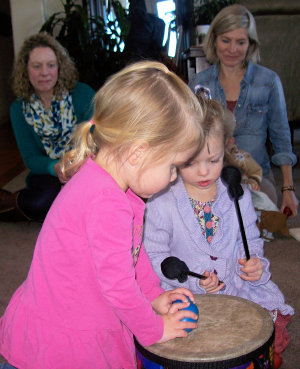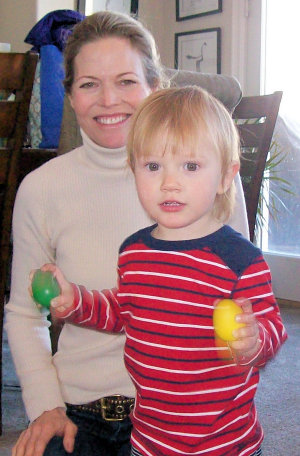 (photo by Maureen Conlin)
(photo by Maureen Conlin)
Music In Bloom
Building Bridges Through Music from School to Home
by Maureen Conlin
Early childhood music educators are provided with so many wonderful opportunities to guide young children on their musical journey and are given many occasions to connect the environments of school and home through music.
Melodies and lyrics that young children learn at preschool and daycare are carried home and sung by the children, enhancing their musical adventure in the home. Whether songs are about eating healthy, cleaning up, covering a nose when sneezing, or brushing teeth, children sing as they learn.
Parents can reinforce this learning in their own home environments when they are given the tools that music educators use. A great way to begin building the bridge from school to home is to provide parents and/or caregivers with a sheet of lyrics using familiar melodies to sing with their child. In addition, post a monthly newsletter, or a “happy note,” for parents to let them know the ways their children are learning and using music.
 (photo by Maureen Conlin)
(photo by Maureen Conlin)
Provide parents with information about games and songs that encourage young children to be creative and imaginative, and encourage them to partner in constructing pathways that provide a flow of music and musical activities from school to home. Model different strategies for engaging children in creative play, e.g., invite parents to ask their child to pick a topic they would like to sing about. If their child suggests writing a song about a dancing dinosaur, one option would be to ask questions: “What does the dinosaur look like? What sound does he make when he is dancing? What dance does he like to do?” The first verse might be “Dancing dinosaurs stomp around, twisting, turning with feet on the ground!” It is then up to the imagination and creativity of the child and their family to complete the song, then share the new song with his or her classmates!
Parents and caregivers may also not be aware of the many resources that are available to them at the public library to enhance their child’s musical journey. Communicating these resources to parents and caregivers is extremely helpful.
Online resources include curated YouTube videos and selected websites highlighting musicians who focus on early childhood music. Libraries also offer invaluable resources, contain robust and engaging collections of CDs and DVDs to borrow, and often host performers and author visits. There are also loads of wonderful children’s books we use in class that can be shared with parents and caregivers, and most are available at public libraries. Some examples are The Maestro Plays by Bill Martin Jr. and Vladimir Radunsky; Orchestranimals by Vlasta van Kampen and Irene C. Eugen; What Instrument Is This? by Rosmarie Hausherr; Zin! Zin! Zin! A Violin by Lloyd Moss; or The Happy Hedgehog Band by Jill Barton. In addition, most children’s collections have a section dedicated to popular songs that have been made into picture books, e.g. “Miss Mary Mack,” “My Favorite Things,” “Fiddle-I-Fee,” and many more.
Consider providing parents with a lending library of resources that families can take home to explore together. This might include CDs, picture books, and songbooks.
The Children’s Music Network is an excellent resource for parents and caregivers with its many accomplished composers, lyricists, songwriters, and early childhood music educators. There is a listserv where members can post a request for a specific type of song (e.g. “Does anyone have a song about rain?”) and receive many suggestions. And don’t forget the booklists on the Member Pages, which include annotated recommendations and even drum and instrument use. Non-members can find treasures in the CMN Song Library’s newly revised Peace Songs for Children and Environmental Songs for Children. Communicate this information to parents so they may increase their resources and renew their interest in their child’s musical education.
 (photo by Maureen Conlin)
(photo by Maureen Conlin)
Encourage parents to have their child bring in backpack-sized instruments from home to share during a musical show and share time. And encourage children to bring home their songs, stories, and activities to share with their families!
Coordinate a “Tune Out and Turn Off Television Week” where there is no television or screen time in the evenings, and offer suggestions for a musical activity for every night during that week. This could include musical games like “Name That Tune,” instrument or song bingo, musical charades, a musical puppet show, or a play and perform evening.
Urge parents to integrate singing into their children’s daily lives: songs for travel from home to school, songs to clean up toys, songs to transition from one activity to the next. We use so many of these in the school or childcare environment but often don’t think to share these songs with parents. Many parents have trouble getting their children to eat healthy foods or even to sit at the table while eating their meals. How grateful a parent would be to have a song encouraging their children to eat “broccoli trees” or “monkey bites” (slices of banana).
Ask parents to explore “found sounds” with children in their home environment. Make a kitchen band composed of pots and pans and wooden spoons, or create sock puppets to animate with silly voices and silly songs. Cut a snowflake from a coffee filter or piece of paper, then dance and float around the kitchen to music.
Creating simple and easy-to-use homemade instruments is another way that parents can become involved in their young child’s musical education. As early childhood educators, we can provide instructions or Internet links so families can work on the project together. The new instrument can then be added to a bandbox of musical instruments all created by the classroom families. Online resources are easily found for rain sticks, maracas and shakers, decorated dowel sticks, jingle bells or jingle shells, tambourines, and drums. The possibilities are endless.
Please invite parents to participate in music time with their children at their school or center. Plan an “informance” where children share the activities they are learning that include singing songs, performing simple dances, and playing rhythm instruments together. It is a wonderful way for parents and family members to see how their child is learning at school.
Building musical bridges from school to home offers many creative and happy opportunities for meaningful connection. Communication is the hammer; creative activities are the nails; songs and musical instruments are the wood, bricks, and mortar; and we, as early childhood music educators, are the architects and builders. Wishing you great success in your construction endeavors!